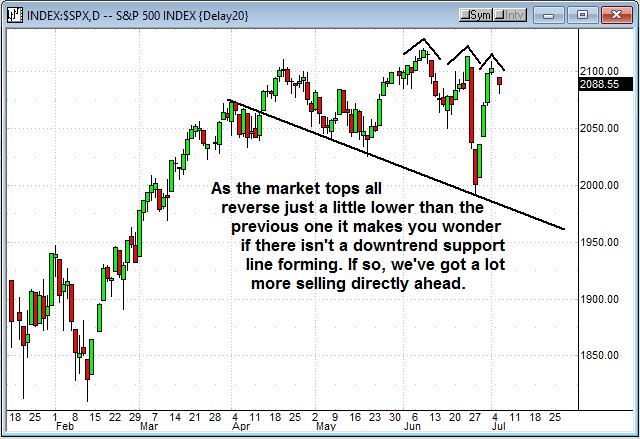Last week the markets enjoyed their biggest 4 day surge of the year. That was impressive, but so far this week–not so much.
Last week's trough to peak 119 point blast higher on the SPX was enough to make us roll one spread up–but we still managed to bag some incredible profits including a stunning 7-day 30% gain on our RUT call spread, and an even more impressive 7-day 39% profit on our SPX call spread.
Those are not only huge spread profits, but our time exposure was down to just one week making our margin money available for new trades just as the market peaked.
Now we've got a new SPX call spread due to expire next Wednesday for a potential 33% gain–returns almost unheard of in the credit spread world.
That's all good news–but what about now? What can we do to turn a profit now that the market is slowing down? To find out let's first take a look at…
The Markets and How They Affect Us
Last week's incredible 4-day blast higher–although impressive–could be rolling over to a fairly steep decline…

The markets rebounded strongly last week as dip buyers rushed in driving the market to their pre-Brexit highs. However we're not seeing that same enthusiam this week.
Earnings season is almost upon us and traders are acting increasingly nervous. Total earnings for the SP 500 index are expected to be down -6.1% from the same period last year on -0.6% lower revenues. Another earnings decline would be the 5th quarter in a row for the SP 500–and the 6th for revenue.
That's pretty daunting when you consider we've never even seen two quarters of earnings declines in a row without a recession.
Meanwhile headlines out of Europe have resurfaced as the pound fell another 2% today to close well under 130 at 127.38. The dollar strengthened and that is going make earnings guidance even tougher as 40% of SP 500 earnings come from overseas.
The Brexit news last week hit the southern European countries especially hard as they were the weakest to start out with. The Wall Street Journal reported this morning that Italian banks are now on the verge of a "full-blown crisis."
In Italy, 17% of banks' loans are sour. That's nearly 10 times the level in the U.S., where, even at the worst of the 2008-2009 financial crisis, it was only 5%. Among publicly traded banks in the eurozone, Italian lenders account for nearly half of total bad loans.
One of the worst is Italy's third-largest lender, Banca Monte dei Paschi di Siena. More than 30% of the bank's loans have already gone bad, and the European Central Bank has asked the bank to slash these nonperforming loans by 40% over the next three years.
The situation is so dire that the Italian government is looking to bail it out for the third time since the financial crisis. But there's a catch…
A new EU bailout rule, which took effect this year, officially requires a "bail in" – where the bank's bondholders and shareholders would shoulder losses first – before it can be bailed out with taxpayer funds. The ECB forced this in Greece and can also do it in Italy–and that is making investors understandably nervous as bank runs are what typically cause severe economic crashes.
That caution is causing money to flee out of stocks to the relative safety of bonds. Yields on the ten-year treasury closed at an historic low of 1.367% today. Records date back to 1789 so a record low is truly an amazing event. The yield on the 30-year treasury fell to a record low at 2.138%, and analysts expect it to fall under 2%.
Part of that is from cash coming from overseas where yields are negative–but part of it is cautionary as investors look for safe havens.
The point is–investors are running out of reasons to buy. The Fed minutes tomorrow will be heavily watched–mostly as to why the Fed switched so quickly from hawkish to dovish at their last FOMC meeting.
It could be they know something about the economy that is causing serious concern.
Underscoring that idea was the ISM-New York survey coming in today at 45.4–still in contraction territory under 50. Employment crashed from 44.6 to 35.9–the lowest reading in over a year. Employment in the NY Zone has contracted in nine of the last ten months. Which means investors will be watching the Non-Farm Payrolls report very closely before the market opens this Friday.
The weight on the market right now is growing–but we're still hovering close to all-time highs–the question is…
How Do We Make Money on It?
In a market like this one where the bottom could drop out at any moment, call spreads sold above resistance are a smart bet–both from a defensive, and profit-making standpoint. Fortunately we've got two excellent set-ups lined up…
Our first trade is a call spread on an index that broke down today after tracing a series of lower highs. That break is the signal we need to collect some generous out-of-the-money call premium for a 9-day 25% gain.
And for our Roth Retirement trade we're also looking at an out-of-the-money call spread for a conservative 9-day 22% profit.
We've got two good looking trades lined up to take advantage of a market seemingly on the verge–so let's get started…
Click here to gain access to today's picks.
Keep up the good work,
Peter
